General Information
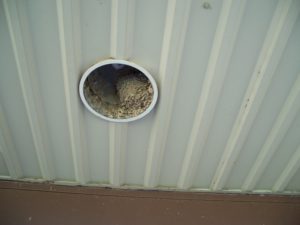
Outdoor lighting can harbor bird nests.
Birds generally considered “nuisance birds” include feral populations of pigeons (Columba livia), house sparrows (Passer domesticus), and starlings (Sternus vulgaris). These species are not native to the United States, and have resulted in many conflicts with humans. Pigeons are represented in nearly all urban and suburban locations and are considered a nuisance.
The first step in your bird control program should be identification of the pest bird; if you cannot positively identify the bird, consult an expert before taking action. The Migratory Bird Treaty and Endangered Species Acts prohibit the trapping or killing of most birds, eggs, or nests without a permit. House sparrows, starlings, and pigeons are not protected under these Acts, but may be covered under local ordinances, so be sure to consult with local wildlife authorities.
Most bird species (including active nests, eggs, and young) are protected under federal and state wildlife laws. Even the small numbers that are not may have local or state humane ordinances that regulate how the birds may be handled.
The presence of these birds in unwanted areas can cause damage to property, and their droppings may create unpleasant odors. Bird droppings can also ruin vegetation, painted surfaces, gutters and awnings, and cause electrical equipment to malfunction. Birds may carry diseases, which are capable of infecting humans, and bird droppings can promote soil conditions favoring development of such fungal diseases as histoplasmosis. House sparrows can damage rigid foam insulation, and their nests can become fire hazards.
Flocks of water birds, especially Canada geese and gulls, are an increasing problem on school grounds, especially athletic fields. In addition to creating a nuisance, these species may damage turf, deteriorate pond environments, and create potential health hazards including slippery footing for athletes due to copious fecal droppings.
A wide range of other situations may result in birds becoming pests at schools. Roosting turkey vultures can become a nuisance with their distinctive sights and smells. Gulls may harass young children for food. Swallows may nest on the sides of school buildings, creating a problem with droppings and mites or dermestids left behind after they move on.
Crows have damaged certain roofing materials. Woodpeckers often drill into wooden buildings. Mississippi kites will dive at people near their nests. Blackbird roosts in trees can be a locally intense problem.
Identification
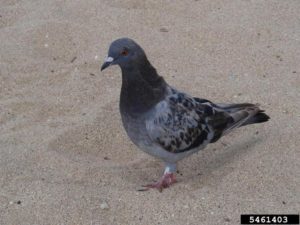 |
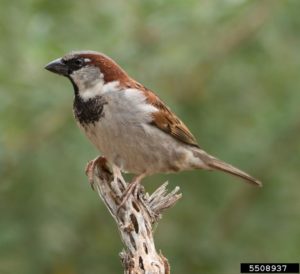 |
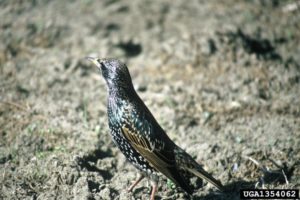 |
| Rock/Feral Pigeon, Columba livia | House Sparrow, Passer domesticus | European Starlings, Sternus vulgaris |
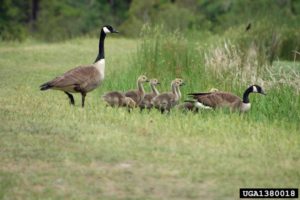 |
 |
|
| Canada Goose, Branta canadensis | Ring-billed Gull, Larus delawarensis |
Suggested Thresholds
- Inside a bus barn or other area occupied by people – Droppings covering ledges or other surfaces
- Exterior perimeter of building – Nests found obstructing equipment, gutters or found on ledges
- Exterior perimeter of building – especially walkway awnings or overhangs – 10 or more birds found per building on three successive inspections.
- Interiors or enclosed areas (courtyards) – Complaints from staff, 5 or more birds seen congregating.
Monitoring and Inspection
Monitoring for bird problems at schools consists largely of logging and responding to complaints, and regular inspections of building exteriors including roofs. Early nesting efforts at problem sites, especially ventilation features, can be discouraged, removed, and, if possible, prevented from reoccurring by exclusion with netting or spikes. Flocking behavior is generally easier to dissuade before bird patterns are well established.
Nonchemical Control Measures
Most bird management procedures fall in this category. The most practical method associated with buildings is to look for areas that can become common nesting areas and develop exclusion methods to prevent the birds from nesting on school property. The best time to do this is during the design review phase, prior to construction or renovation. In addition to design changes to avoid creating nest or roosting sites, a wide range of approaches are available from common building materials to bird netting, spikes, and specialized products including electric tracks. Exclusion of geese and gulls from ponds is also possible using posts and wire or line.
Sanitation/Cultural Control Measures
- Habitat modification and exclusion from structures are generally the most effective ways of controlling nuisance bird populations.
- Note where birds are roosting, nesting, and landing; look for nests and droppings.
- Eliminate potential food and water sources if possible.
Physical/Mechanical Control Measures
- Use bird spikes for window ledges or other ledges made of wood, plexiglass, or stone. Also, a plastic or other hard material device may be installed at a 45-degree angle to prevent perching. Insure that ends are closed as well.
- 1/4 inch screen or net mesh is recommended to keep all bird species out of these areas.
- Screen undersides of rafters with nylon netting, (cut velcro-attached panels into the netting to allow for service equipment access to rafter areas).
Biological Control Measures
Avian Reproductive Disruption
A relatively new product, Ovocontrol®, was recently registered for use on pigeons and geese. It reduces reproduction by impacting the hatchability of eggs. This product requires continued use during the breeding season, which can be year round for some species. Nicarbazin was developed by Merck in the mid-1950’s as an anticoccidial drug for use in poultry. Mixed into the feed, the drug prevents coccidiosis, an often fatal disease in young chickens. Interference with egg hatchability was an unwanted side effect occurring when medicated feed was inadvertently fed to breeder chickens. Nicarbazin has an acute toxicity value equivalent to table sugar, so is an attractive option for area-wide management of pigeons on school sites.
Chemical Control Measures
PiGNX®, with capsaicin as the active ingredient, is used to prevent the roosting & congregation of pigeons in unwanted areas. PiGNX® Caulking Gel acts as a bio-repellent and deterrent for pigeons.
Other tactile repellents are also available. Repellents containing polybutenes form a tacky, non-drying, adhesive surface that is uncomfortable for pigeons and other birds. Polybutylene repellents can be applied to ledges or beams to prevent roosting. These repellents are non-toxic, but feel sticky and unpleasant to birds attempting to land. Apply repellent in tight wavy closely spaced rows. Repellents must be reapplied with some frequency as they can become coated with dust or leaves and lose their sticky feel. Apply masking tape to the surface prior to using the repellent so that it may be more easily cleaned up and reapplied. Repellents are best suited for small- or medium- sized infestations.
Additional avian aversion agents on the market contain methyl anthranilate as an active ingredient. Methyl anthranilate repels birds when it is applied to a food source, but does not harm them. It works by irritating pain receptors associated with birds’ senses of taste and smell. Birds find this compound unpleasant and tend to avoid treated materials.
Avitrol® baits are poisons with flock-alarming properties that are classified as restricted use pesticides due to acute avian toxicity. Avitrol® is for sale to and use only by Certified Applicators or persons under their direct supervision and only for those uses covered by the Certified Applicator’s Certification. Birds that have fed upon the bait exhibit distress behavior that frightens the rest of the flock away. The baits are registered as chemical frightening agents (repellents) for use on pigeons, house sparrows, starlings and other species. The product is usually fatal to birds that react and alarm a flock. The product remains toxic to any bird that eats it even once it is in a bird’s digestive tract. The possibility of a negative public reaction to dying birds needs to be considered when making bird management decisions. Many schools and some pest management companies will not use this product because of the risk of children and other non-target species ingesting Avitrol®-treated bait.
Always read and follow the directions on the pesticide label. It is a violation of Federal law to use a pesticide in a manner inconsistent with label instructions. Pesticides must be used in accordance with all federal, state and local regulations. Applicators must have proper credentialing to apply pesticides and should always wear all personal protective equipment (PPE) required by the pesticide label during applications. All labels and Safety Data Sheets (SDS) for the pesticide products authorized for use in the IPM program should be maintained on file.
Evaluation Methods
Reduction in nuisance bird complaints by teachers and staff. Remember to remove any nesting material and observe for secondary ectoparasites from avian species in and around nesting areas that humans may have contact with.
Authors: Compiled from publications by Lesley Godfrey, Janet Hurley,
